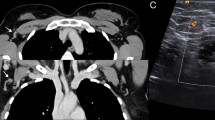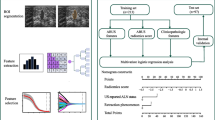Abstract
Purpose
The goal of this study is to develop a computerized method that identifies a specific axillary lymph node (ALN) seen on ultrasound (US) with its most likely corresponding node on breast MRI (BMRI). This goal is an important step in developing a preoperative non-invasive method for staging breast cancer on the basis of multi-modality imaging.
Methods
Twenty patients with newly diagnosed breast cancer were scanned on US and MRI. Two expert breast imaging radiologists independently correlated ALNs seen on US with BMRI, and this correlation was used as the gold standard. To correlate ALNs on US and BMRI, the cortex and hilum of each ALN was segmented using an ellipse fitting algorithm, then the ALN long and short axes and maximum cortical thickness (MCT) were computed. Three ALNs were chosen as candidates from the BMRI datasets for each lymph node seen on US. Finally, the Euclidean distances across all measurements between the US ALN and each of the three BMRI candidates were computed, and the smallest distance was reported as the correlation result.
Results
Using the expert radiologists identified correlated BMRI slice as the ground truth, the shortest Euclidean distance successfully identified the same lymph node as the radiologists in 13 out of 16 ALNs (81.25%). In negative ALNs, the standard deviation for long and short axes was relatively large but that of maximum cortical thickness was small. Average maximum cortical thickness and its standard deviation measured in US were very close to those measured in MRI. There were no significant differences among the long axis, short axis, and MCT measurements between US and MRI-T2 weighted sequence (P > 0.05 paired t-test).
Conclusion
We performed a feasibility study which showed that computerized measurements of ALNs might be used to identify the same ALN on different modalities such as US and BMRI. This type of correlation would be valuable as it would allow the use of combined imaging parameters to be applied to the evaluation of ALNs in patients with breast cancer. It is hoped that the combined multi-modality information would provide a more robust non-invasive method of staging the axilla than is currently available.
Similar content being viewed by others
Explore related subjects
Discover the latest articles, news and stories from top researchers in related subjects.References
Fraile M, Rull M, Julian FJ et al (2000) Sentinel node biopsy as a practical alternative to axillary lymph node dissection in breast cancer patients: an approach to its validity. Ann Oncol 11: 701–705
McMasters KM, Giuliano AE, Ross MI et al (1998) Sentinel-lymph-node biopsy for breast cancer—not yet the standard of care. N Engl J Med 339: 990–995
De Kanter AY, van Eijck CHJ, van Geel AN et al (1999) Multicentre study of ultrasonographically guided axillary node biopsy in patients with breast cancer. Br J Surg 86: 1459–1462
Grube BJ, Christy CJ, Black D et al (2008) Breast sentinel lymph node dissection before preoperative chemotherapy. Arch Surg 143(7): 692–700
Backus J, Laughlin T, Wang Y et al (2005) Identification and characterization of optimal gene expression markers for detection of breast cancer metastasis. J Mol Diagn 7(3): 327–333
Britton PD, Goud A, Godward S et al (2009) Use of ultrasound-guided axillary node core biopsy in staging of early breast cancer. Eur Radiol 19: 561–569
Eisenhauer EA, Therasse P, Bogaerts J et al (2009) New response evaluation criteria in solid tumours: revised RECIST guideline (version 1.1). Eur J Cancer 45: 228–247
American Cancer Society guidelines for breast screening with MRI as an adjunct to mammography. http://caonline.amcancersoc.org/cgi/content/full/57/2/75
Lehman CD, Gatsonis C, Kuhl ChK et al (2007) MRI evaluation of the contralateral breast in women with recently diagnosed breast cancer. For the ACRIN Trial 6667 Investigators Group. N Engl J Med 356(13)
Arbash Meinel L, Bergtholdt M, Abe H, Huo D, Buelow Th, Carlsen I, Newstead G (2009) Multi-modality computer-aided diagnosis system for axillary lymph node (ALN) staging: segmentation of ALN on ultrasound images. SPIE Med Imaging
Zhang Z (1997) Parameter estimation techniques: a tutorial with respect to conic fitting. Image Vis Comput 15(1): 59–76
Fischler A, Bolles RC (1981) Random sample consensus: a paradigm for model fitting with applications to image analysis and automated cartography. Commun ACM 24: 381–395
Abe H, Schmidt RA, Kulkarni K, Sennett CA, Mueller JS, Newstead GM (2009) Ultrasound-guided 14G core needle biopsy of suspicious axillary lymph nodes in patients with breast cancer: clinical experience in 100 patients. Radiology 250: 41–49
Britton PD, Goud A, Godward S et al (2009) Use of ultrasound-guided axillary node core biopsy in staging of early breast cancer. Eur Radiol 19: 561–569
Arbash Meinel L, Abe H, Bergtholdt M, Schmidt R, Newstead G (2010) Computation of maximum cortical thickness of axillary lymph nodes on ultrasound images. In: CARS 2010 (submitted)
Nathanson SD, Burke M, Slater R, Kapke A (2007) Preoperative identification of the sentinel lymph node in breast cancer. Ann Surg Oncol 14(11): 3102–3110
Author information
Authors and Affiliations
Corresponding author
Rights and permissions
About this article
Cite this article
Meinel, L.A., Abe, H., Bergtholdt, M. et al. Multi-modality morphological correlation of axillary lymph nodes. Int J CARS 5, 343–350 (2010). https://doi.org/10.1007/s11548-010-0421-z
Received:
Accepted:
Published:
Issue Date:
DOI: https://doi.org/10.1007/s11548-010-0421-z




